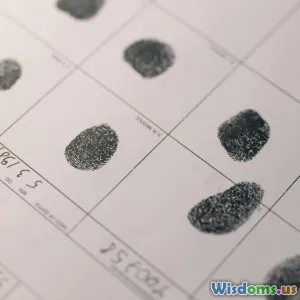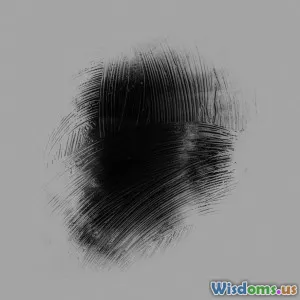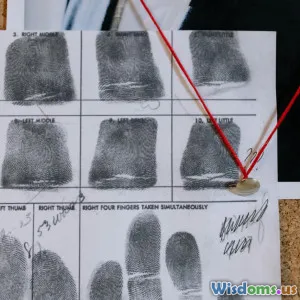
Comparing Digital Forensics and Traditional Evidence Collection Methods
8 min read Explore the critical differences between digital forensics and traditional evidence collection in modern crime investigations. (0 Reviews)
Comparing Digital Forensics and Traditional Evidence Collection Methods
Introduction
In the relentlessly evolving world of crime investigation, how evidence is gathered can make or break a case. Traditional methods—collecting physical evidence from a crime scene—have been central to investigative procedures for decades. Yet, with rapid technological advancement, digital forensics has emerged as an indispensable specialty that tackles evidence in intangible form: data, devices, and networks. This article explores the intricate landscape of both digital forensics and traditional evidence collection, uncovering their defining characteristics, applications, and the transformative impact on modern criminology.
Understanding Traditional Evidence Collection
Foundations and Practices
Traditional evidence collection encompasses the physical securing and documenting of tangible objects and materials related to a crime. This includes fingerprints, weapons, blood samples, fibers, and eyewitness reports—all essential for reconstructing events and identifying perpetrators.
For example, the meticulous collection of fingerprints at a burglary scene can decisively link a suspect to the location. Similarly, DNA sampling has revolutionized suspect identification, with databases like CODIS offering comparison frameworks that have helped exonerate the innocent and convict the guilty.
Strengths and Limitations
The strengths of traditional methods lie in their undeniable physicality—objects and residues that can be directly handled, tested, and presented in court. However, these approaches face several hurdles:
- Contamination Risks: Improper handling can degrade or contaminate evidence.
- Environmental Exposure: Weather and time can degrade physical evidence.
- Scope Limits: Certain crimes, especially cybercrimes, leave little to no physical footprint.
Despite rigorous protocols (such as chain-of-custody documentation), the susceptibility to human error remains a notable challenge.
The Rise of Digital Forensics
Definition and Core Components
Digital forensics is a branch of forensic science that focuses on the recovery, investigation, and analysis of material found in digital devices—computers, smartphones, servers, and networks.
The discipline emerged prominently in the late 1990s as criminal activity increasingly intersected with computers and the Internet. Techniques in digital forensics include:
- Data Acquisition: Creating bit-for-bit copies of device storage without altering original contents.
- Analysis: Recovering hidden, deleted, or encrypted files, and examining logs.
- Reporting: Documenting findings with technical clarity for legal proceedings.
Examples in Action
A notable case highlighting digital forensics is the investigation of the Sony Pictures hack in 2014, where forensic experts analyzed malware traces, log data, and network activity to identify the perpetrators reportedly linked to a nation-state.
Digital forensics has also become pivotal in extracting evidence from smartphones in cases such as fraud, cyberbullying, and murder, thus expanding the investigative toolkit far beyond the physical realm.
Opportunities and Challenges
Digital evidence allows investigators to probe vast amounts of data at high speed. Additionally, digital traces are often timestamped and logged, providing invaluable timelines.
However, several challenges complicate digital forensics:
- Encryption and Privacy: Increasing use of encryption and privacy-focused systems inhibits access.
- Data Volume: Handling terabytes of data demands significant resources and expertise.
- Dynamic Nature: Digital environments can change or be remotely altered during investigations, raising concerns about evidence integrity.
Contrasts Between Digital and Traditional Methods
| Aspect | Traditional Evidence Collection | Digital Forensics |
|---|---|---|
| Nature of Evidence | Physical and tangible | Electronic and intangible |
| Handling Risks | Physical contamination and degradation | Data alteration, overwriting, or deletion |
| Investigative Tools | Physical tools, chemical tests, visual inspection | Specialized software, hardware duplicators |
| Scope of Crime | Violent crime, burglary, drug evidence | Cybercrime, financial fraud, intellectual theft |
| Legal Considerations | Long-established legal standards | Emerging frameworks, evolving case law |
Integrating Both Worlds: A Holistic Approach
In truth, modern investigations can rarely afford to rely on only one method. Cases frequently overlap, involving both physical and digital dimensions.
For example, in drug trafficking investigations, officers seize physical substances and simultaneously analyze cell phones to map communication networks and financial transactions.
Law enforcement agencies increasingly train personnel in both disciplines. Joint task forces may include both traditional forensic experts and digital forensic analysts, facilitating comprehensive evidence collection and case-building.
Conclusion
Traditional evidence collection and digital forensics represent two pillars supporting contemporary crime investigation. Each offers unique methodologies and confronts distinct challenges. However, their integration fosters a richer and more reliable evidentiary landscape, crucial for justice in an age shaped by technological complexity.
As criminals exploit digital domains to enhance and mask their activities, the significance of digital forensics will undoubtedly accelerate. Yet, the fundamental need to preserve and analyze physical evidence remains steadfast. For practitioners, researchers, and legal professionals alike, understanding the nuances of both methods is key to navigating the evolving frontier of criminology.
Further Reading:
- Casey, E. (2011). Digital Evidence and Computer Crime. Academic Press.
- Fisher, B. A. J. (2013). Techniques of Crime Scene Investigation. CRC Press.
- NRC. (2009). Strengthening Forensic Science in the United States: A Path Forward. The National Academies Press.
Quotes: "Digital forensic science is an evolving discipline at the intersection of technology and law enforcement." – Dr. Gilbert Peterson, Forensic Analyst.
"Physical evidence tells the story where words fail; digital forensics deciphers the code where actions hide." – Detective Sarah Kim, Cybercrime Division.
Rate the Post
User Reviews
Popular Posts


















